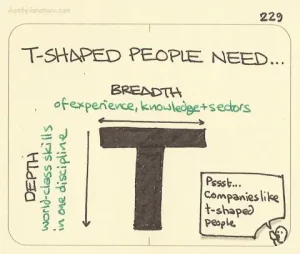A New Strategy For Corporate Learning: Growth In The Flow Of Work
The corporate training industry is over $320 billion in size and growing in importance every day. Companies are struggling with employee retention, transformation, and challenges with hybrid work while technologies and industries change faster than ever. How can CEOs and CHROs keep up? The answer is very clear: build an enterprise capability in learning, capability development, and career growth.
The latest numbers are staggering. More than 30% of US workers will voluntarily change jobs this year and more than 60% of them are changing industries. Why? Two big reasons: first, people are fed up with their difficult or over-worked positions in their current job. Second, people with strong skills are simply taking their skills with them to a better position.
And the era of employee empowerment is working. New research by Protocol shows that people who “jump employers” see almost a 30% higher wage increase than those who stay in place, and a new study by Pew Research found that job hoppers this quarter gained 9.7% in wages while those who stayed in place lost 1.7% in earning power.
What’s the answer for employers? Don’t just lose people like this. We have to build capability for what we call Growth In The Flow Of Work.
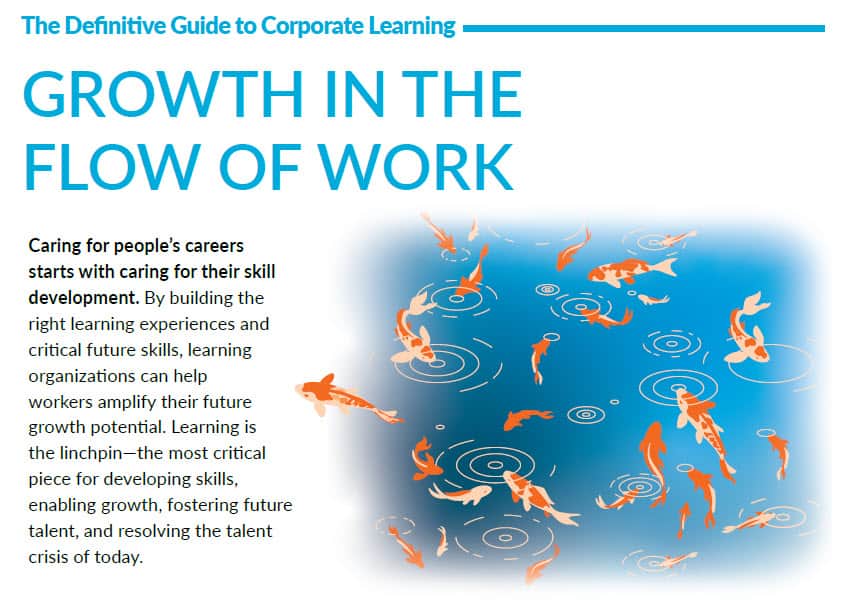 |
A New Phrase But Not A New Concept
Before you think about this as a cute phrase, let me tell you this research is the result of more than twenty years of my career. I led major studies of corporate training since our very first study (The High-Impact Learning Organization) in 2004 and the trend is clear. Corporate training teams are flooded with new technologies and designs, hundreds of vendors, and thousands of courses and programs. And as we studied the factors that drive success two big things came out: relevance and growth.
In other words, as our new research points out, among the 100+ practices we studied, the things that matter the most are the relevance of your learning offerings, and the way they impact growth. And this makes perfect sense: people are busy, they’re stressed in their jobs (81% are burned out), and they want their employer to help them grow. If you can deliver relevant learning opportunities (and this itself is complex) that help people grow, you’re really moving the needle.
Growth In The Flow Of Work was coined by Nehal Nangia, our senior analyst who led this effort. After a year of research and discussions with hundreds of training leaders, we discovered that growth is what really matters. In fact, I was joking around with her this week that maybe it’s time to rename the Chief Learning Officer to the Chief Growth Officer.
After all, what’s the point in learning if it doesn’t help you grow?
Here’s The Real Research
This body of research, which is available to our corporate members, is the most comprehensive study of corporate training we’ve done. We surveyed more than 1,000 companies on 100+ business practices and correlated all the various investments to three major outcomes: financial results, human capital results, and growth and innovation. And here is a high level of what we found.
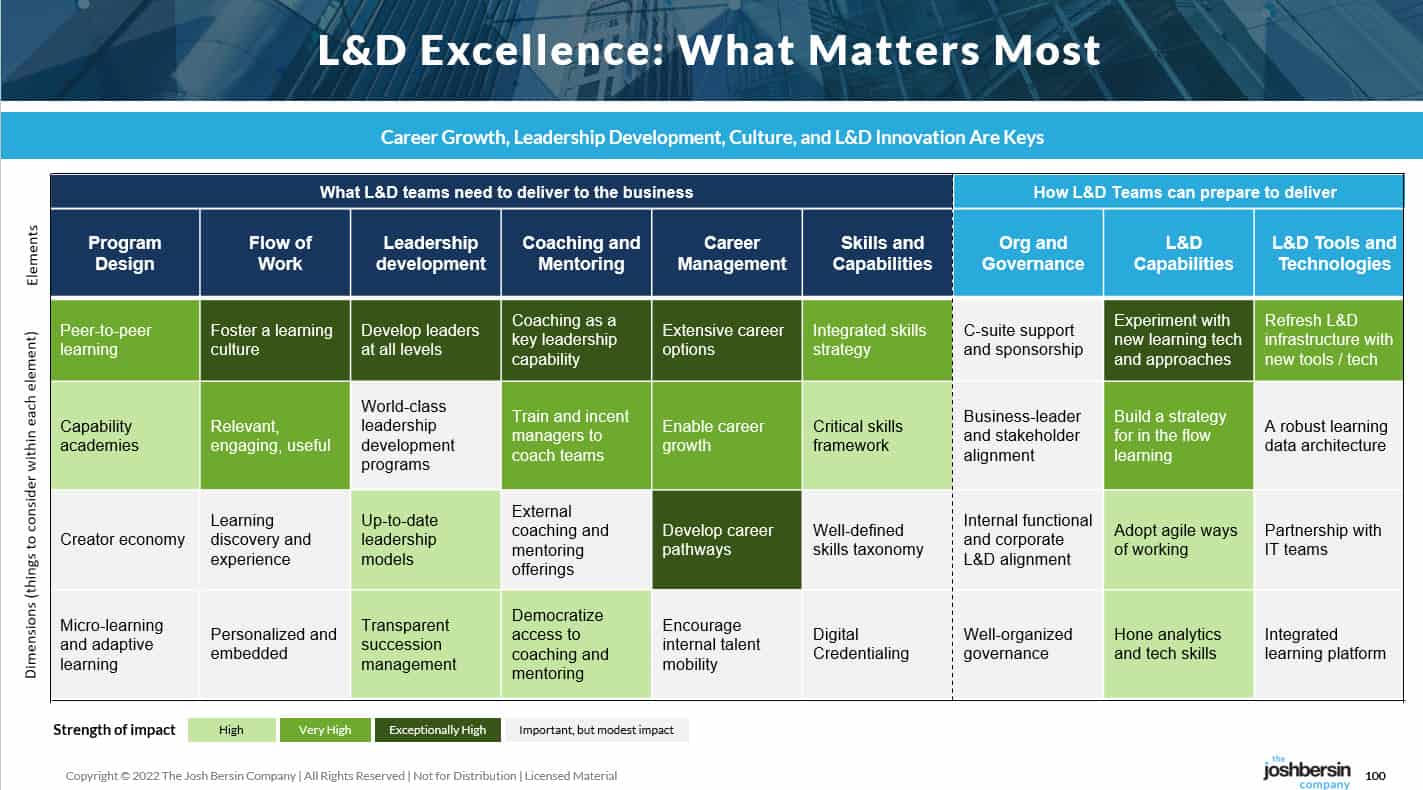 |
As you can see from this chart, we detailed the “what” and the “how.” And as the data clearly shows, the four big drivers are career growth programs, leadership development (which creates a growth mindset), learning culture (which facilitates mentoring, job mobility, and discussions), and L&D innovation (you have to invest in skills technology, micro-learning, and all of the new platforms).
How Do You Do This?
It’s easy enough to detail the recommendations, but how do you pull this off?
Our research correlated these practices to business results and the top 15 are surprising. Career Management (developing career pathways, creating career coaches, giving people self-service career tools) is by far the #1. Right behind this are a bunch of practices in management and leadership: developing leaders at all levels, teaching leaders to develop others, and giving leaders better Power Skills). The third category has to do with L&D excellence: corporate training groups have to experiment with new technology, build a “learning in the flow” strategy, and learn to publish, organize, and manage content. And then of course the need for skills taxonomies, capability academies, and focus on employee exposure and mobility rank high.
Over the years we’ve consulted with so many companies I’ve tried to keep track of everything we’ve learned. Here is the big picture, much of which is also discussed in my new book Irresistible.
 |
Skills Alone Are Not The Panacea
Let me mention the huge discussion about skills.
As many have heard me talk about, there’s too much noise about “skills as the currency of success.” That statement is not entirely true. Yes, we each need granular skills to do our jobs. But we can’t really use these skills, hone them, or apply them unless we have context, experiences, mentoring, and wisdom. This “wisdom” comes through growth: taking a stretch assignment, working on a new project, or meeting someone who can help you fill in the gaps.
Here’s the way this works. There’s no point going to training if you don’t build the right skills; there’s no point building a skill if you can’t apply it on the job; and there’s no point creating a capability unless it can help you grow, expand, and do new things. That’s what’s going on – we’re stretching the role of L&D to focus on growth, not just learning.
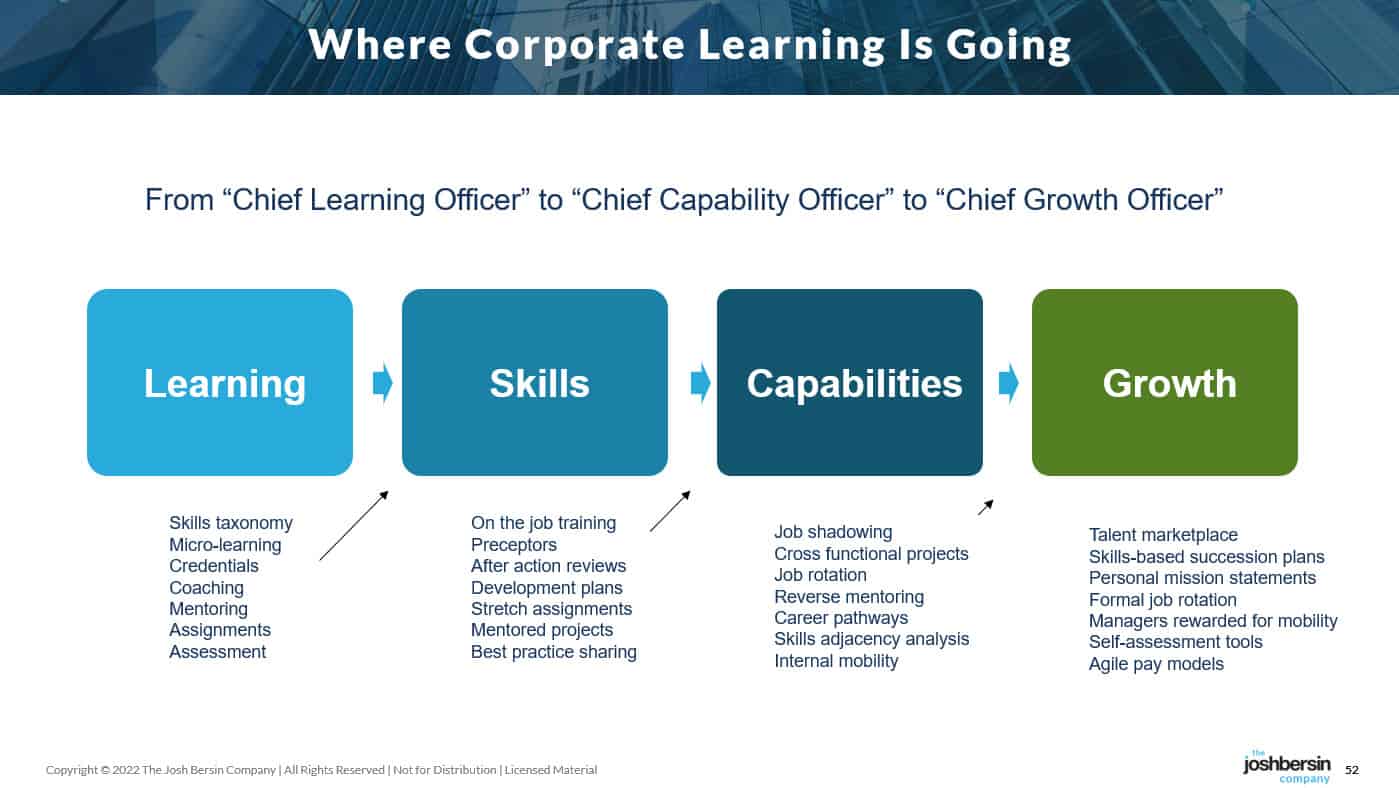 |
The Value Of T-Shaped Or Multi-Disciplinary Skills
And Growth is not just about making people feel better (which it does). Every success in business is built on multi-disciplinary skills and learning by experience.
A new McKinsey study shows that most of an employee’s long-term earnings growth comes from experience, not skills. In other words, if people are not growing through new roles, jobs, and projects, skills-development alone provides limited value.
We know this in our own lives: a course or test may increase your knowledge or awareness, but real capabilities come through experience on the job. This is why “growth” is such an important role for L&D.
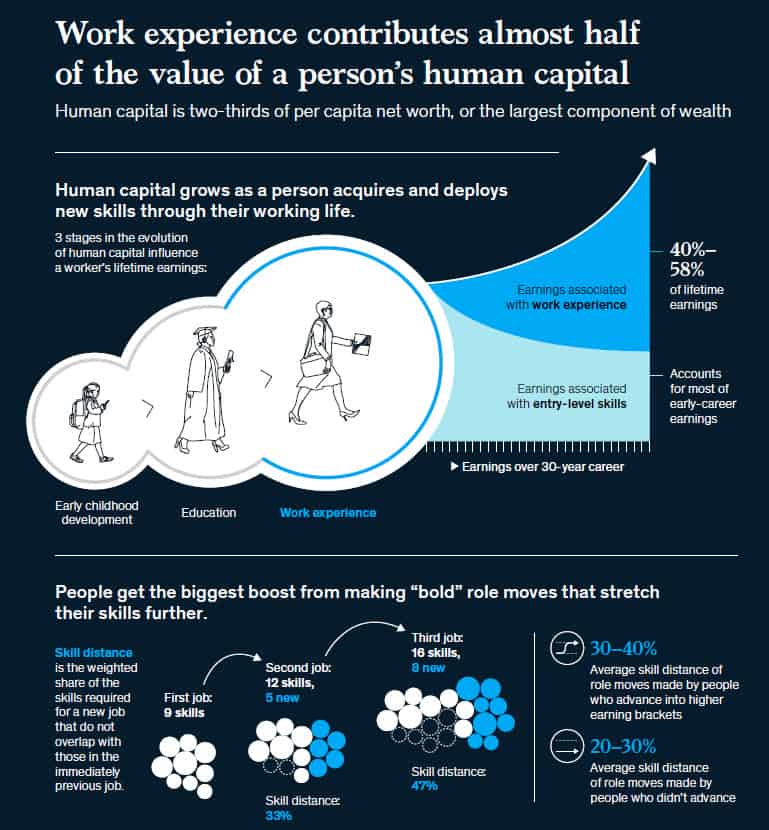 |
T-Shaped Skills or Full Stack Professionals
On the topic of T-Shaped skills, much research now proves that scientists, engineers, and most business people benefit from multi-disciplinary skills. We often call this the T-Shaped Career. (You specialize in one thing and then broaden yourself horizontally in adjacent skills.)
I often call this Full Stack Skills, similar to what software teams call a Full Stack Engineer. (Read about Full-Stack HR here.)
When I interviewed Vidya Krishnan, the CLO at Ericsson about their plans to develop skills in 5G, she explained to me that this new technology, which started as a stack of technologies, has now changed everything in the telecommunications industry. New products and services, new business models, and new consulting skills have been created. These “multi-disciplinary” skills are changed by 5G, so a great 5G engineer or product manager needs to understand these adjacent domains.
In the public sphere think about global climate change. No single technology can address this issue: we need energy engineers, economists, behavioral scientists, and politicians to come together. In the context of a company, this is a “cross-functional team” which comes together through talent mobility, job rotation, and lots of collaboration. The L&D team has to be part of supporting and encouraging this process.
 In my upcoming book, Irresistible, I discuss the different types of cross-functional teams and how and why they drive value. This, again, is part of the “Grow” mission that has to be built into L&D.
In my upcoming book, Irresistible, I discuss the different types of cross-functional teams and how and why they drive value. This, again, is part of the “Grow” mission that has to be built into L&D.
What Does This Mean For HR and L&D Teams
We don’t do this research for academic purposes: there is a clear roadmap for success here. HR and L&D teams have to step through this maturity model and work on the next big thing.
Here is a way to think about it. Many of the innovations in HR: micro-learning, LXP platforms, skills engines, capability academies, and the talent marketplace – now all fit together. Yes, you have to build compliance training, onboarding, technical training, and operational skills. None of that has gone away. But you, as an L&D or HR leader, have to put this into the context of growth.
In other words, many of the problems we solved in the last two decades have moved from “exciting and differentiated” to “must-have” or fundamental. If you go out and buy an LMS and fill it with content, you’ve reached the pinnacle of success for circa 2014 training departments. If you go out and buy an LXP and flood it with content you’ve caught up to the era of 2018 or so. Today you have to go further. You have to build a capability academy team, work with the talent and recruiting organization to discuss mobility and career paths, and invest in talent intelligence to understand the skills and careers of the future.
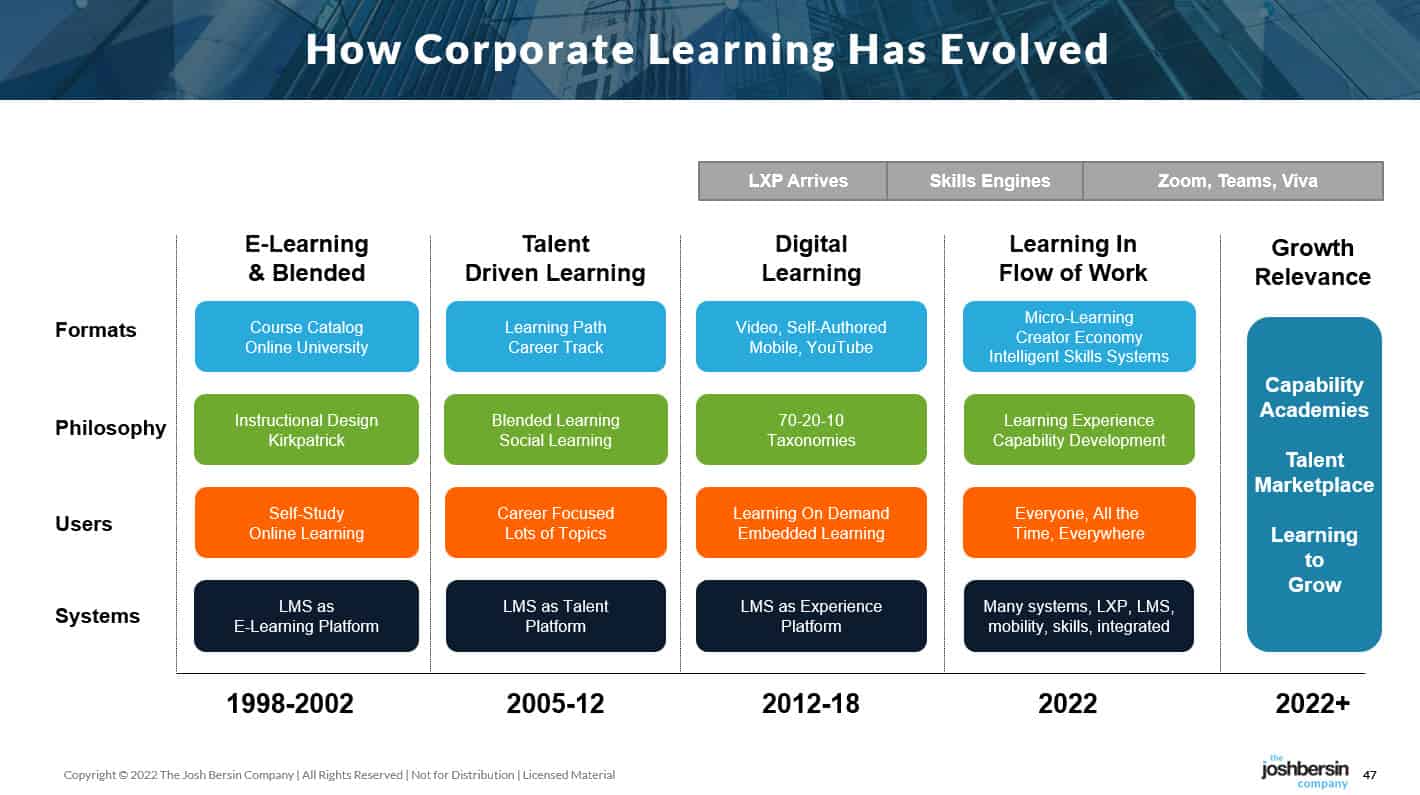 |
The Healthcare Industry As An Example
Let’s look at healthcare as an example. In September we are launching our new Global Workforce Intelligence research in our first industry: healthcare. After ten months of study, we realized that healthcare organizations are among the most advanced and sophisticated thinkers in HR. Their problems are dazzlingly complex: a massive shortage of clinical professionals, very high rates of turnover, and a skills taxonomy that would make your head spin. Think about all the new diagnostics, tools, diseases, and procedures being invented every week. Well, they have to be life-or-death trained on everything.
How do they do this? While they aren’t particularly advanced in L&D technology, they invest heavily in career pathways, adjacent skills analysis, internal mobility, and lifelong career growth for employees. You can join a great company like Providence or NY Presbyterian or Advent Health and start as a health aid and move to a $100,000 career in only five years. You’ll get coaching, mentoring, development, and enormous exposure to new jobs – built on a culture of care.
Greg Till, the CHRO of Providence, talked about the “Dyad Leadership” model of healthcare: clinical experts are paired with operational experts to design new procedures, develop operating models, and monitor measures of success. This idea, of pairing a technical expert (the doctor) with an operational expert (the functional leader) is actually not very common in other industries. Why do they do this? Healthcare companies know that deep skills are essential to success – but alone they don’t scale if we don’t “operationalize them” in the organization.
For many of you, this means building new career pathways, creating capability academies, and working with your HR team on the internal talent marketplace. CLOs are often the most interdisciplinary leaders in HR: now is the time to spread your wings and help lead these important projects.
I could go on and on, there’s so much to learn. Here is Nehal’s overview and I invite you to join our corporate membership for more.
Additional Resources
Learning In The Flow Of Work: A New Paradigm
